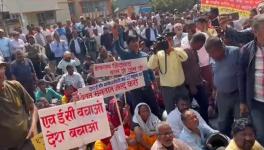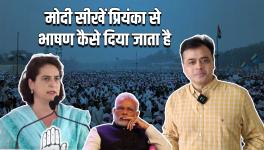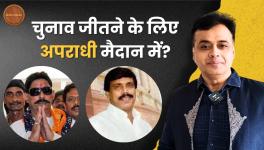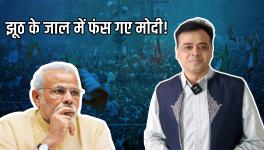'Traditional Puppeteers have to be Nurtured.' Part II
In the second and final part of his conversation with Newsclick, celebrated puppeteer Dadi Pudumjee shares his views on censorship, breaking new ground in puppet theatre and the use of technology in contemporary modern theatre. He also insists that traditional puppeteers should be nurtured, promoted and provided means to travel abroad and gain exposure.
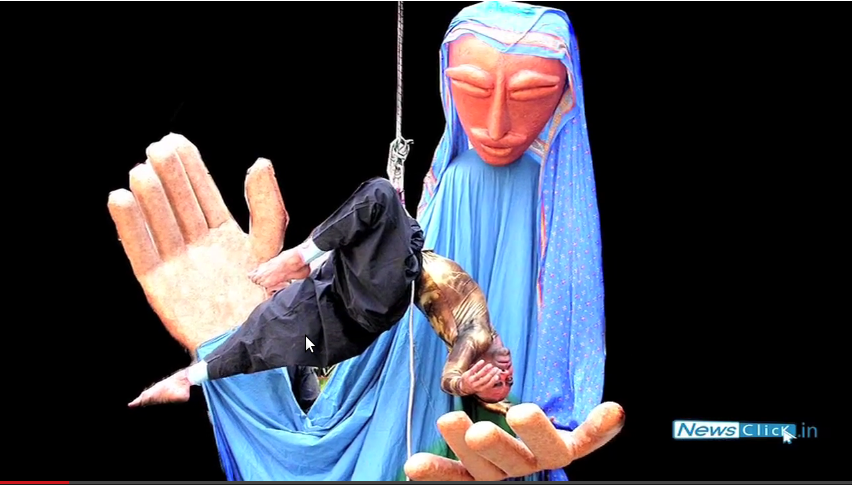
Pranav Brara (PB): The freedom of expression in our country and countries abroad. I mean yes, in certain ways we usually crib about the freedom of expression in our country unless we see people and artists from Iran or when they see the western world because the freedom of expression is more there. Have you ever feel challenged or you have struggled with the fact that you want to say something through your puppets and you could not say that because of freedom of expression or you invited a play from may be from any other country from international festival Ishara annual international festival. You had problems with that?
Dadi Padumjee (DP): No, I haven't seen any... really I haven't faced that problem. I would say that I didn't think so much about it early days. Today, I think about it if I am using this colour or that colour what would it mean. Things have become more sensitive today. People are less I find at one side we say it is very egalitarian, open, but at the same time I find people very... yeah the issues are sometimes raised whether this religion, society and gender issues things like that. I remember early, what was it.. about fifteen, twenty years ago before the political satire, the rubber, the latex puppets came on to NDTV, we used to do something called eye witness, Karan Thapar used to run for Hindustan Times video magazine called eye witness and India Today also had one and these every fortnight would come to your door. You subscribe to it. In that there was a five minute programme called funny things which was parliament news and similar ones this latex puppets were much cruder there's finesse in the technique now. But the humor and the satire was sometimes far more biting. It wasn't that. But I remember that it used to go through censors. If, you know, if you use symbol or this, this or that it has to be equal for every group or party. The president would not touch. It was the others, there was those things but I don't know it seems today I haven't directly faced any problem. It seems today for instance that there could be things, recently for instance, we had Spanish group. It was based on Bernad Alba but she called it Bernad's backstage. It was all about women's issues and things like that. Now Spain she had puppets totally nude and things you know and the way she was moving with the puppet and things like that and that could have problem in a public viewing and I would say if it was done that way. She spoke to us and then she made a puppet wear very light cloth something like that. Now, I don't know whether it was right to do or not right to do it but I do know that people get extremely sensitive. Though at one point they say there is no problem but
PB: There has been this whole thing in the theatre circuit about the theatre is a vast medium. It is this new media thing which has come out. It has in a way gone closer to cinema because though cinema has come from the theatre now it seems theatre is moving towards cinema with all new graphics, 4D projections that are coming in. Every theatre director finds something else apart from the performance which can enhance the aesthetics of the play and puppet is one of them. Do you feel that puppetry has become in a larger sense of theatre just a medium to change the aesthetics in a way and also that a lot of, lot of artists, actors, directors feel that puppets are someone that they have to channelise. Whereas I read a quote recently saying that puppets communicate, they are direct emotions, they are metaphors, they are images.
DP: See, it is how you use the medium. Things are sort of levelling. Dancers are looking for something. New puppets are coming. Masks are being used. This that... I remember 1980 when I first did one of the performances of folk tale from Punjab and we had our puppeteers coming out and singing like actors and everyone's saying what is it, why actors with puppets. You know puppets are puppets only. Then this became a chain and became a style of doing things. Now everybody is using it. All over the world it has been that way. Lets say if you are talking about Indian folk theatre in India it has never been so boxed, that this is dance, this is drum whatever, it is a mix of things. So earlier western concept that said, this is theatre, this is ballet, this is dance, this is puppetry which is they have also changed it now. They are using new medium. Digital animation, film, projections and things like that and that's the prerogative of the director, the artistic director, the designer how they want to communicate. Even for me, the puppets are still a medium. I use them with other things as you see with actors, dance. But for me as a puppeteer puppets are the central theme. Very often some dancers want to use puppets and I have seen that they become props. That's how they want to use it. That is upto them and eventually what happens there also the puppets are dominating without the person who wanted not that to happen, without realizing that happens because it is a sort of objective theatre and what you said this quote which comes from Arther Graham which is quite true because it is the inanimate, animate whatever you say, the Mecca of theatre of the dead coming alive. We need to watch these things even though you know that it is not real.
PB: the suspension of the disbelief.
DP: Yeah, the suspension of disbelief. That plays an important part in a well manipulated puppet. If it just performing and moving around and shaking it doesn't work that way. It come very quite bad but I have only used one scene of piece called transposition some digital animation which was done by Vishal --- he did long ago 2001, 2002. After that I haven't used electronic media to that extent. I have used projectors, I have used OHPs that is still very manual. I find that still in my control. I like to do that because if you are using a technique, you have to master that technique. I haven't and very often we do that without realising that other countries in the world are doing it far far more better. We try to get over by saying we are expression things we are saying it in a …. it is not the look of it but we are trying to say things are that... but if you are using technical stuff you have to able to use it well.
PB: Also, the expression for actors and for the puppets and though theatre is an exaggerated form because it really needs to reach out to the people who are watching. I have also witnessed that because our theatre and acting comes from Natya Shastra which is also a form dance and other whole techniques of expressing and loud. Do you think that sometimes also in theatre with puppet the concept of less is more is prevalent.
DP: It is. Yeah. Definitely it is. But it again depends on how the director uses it. I mean, fifteen twenty years ago large things with puppets and they were imitating life theatres, miniatures and people said wow look how realistic is that and other things. Today it is not like that. Today a lot of puppetry is being at world stage. The biggest success story which is going on is war horse. Not the film, the stage play. The South African company has made it a business. They are making this horse puppets and they are going all over the world to different stages and beautifully moved it if anyone is interested can go to you tube and see clip of these things. Totally, artificially looking large horse with strips of leather and all. When you seen the puppeteers move it the way the puppeteers and the way the horse moves and I haven't seen this. They say it is so powerful you are almost in tears in the end of it when the puppet dies. The other big thing is the lion king. Julie Tamor a very very famous puppeteer who had a bases in Indonesia, she created that and it is going all over the world where she used masks, puppets. Everywhere there is someone trying to do something with puppet, there is an Indonesian famous puppeteer Imade Sida, I think he now lives in Australia. He has a grand productions with traditional shadow puppets made larger and projected image, dance from his own tradition but he used technique in a slightly big Broadway style. So when you have opportunity what to do with it depends very much on you either the contemporary modern puppeteers are all urban based more or less at least in India. So their issues, the things will be focused on that. We have far more number of traditional puppeteers who are living in the rural areas in villages and they are one who needs to see new things you know which happens during the festival. Try to see what can be done even within the tradition keeping the tradition alive as they say.
PB: How different it is for example a Rajasthani Folk may be Katputli as it is usually called, to a modern urban Delhi puppeteer? They work their priorities their issues and the form they choose. Is it very different from each other to understand each other and come to a kind of a level whereby the form becomes common. Or it's still very different from each other or it's a kind of rebel attitude from a modern urban theatre, a puppet theatre makers to not to go to the folk form because that has been done since a lot of time. They are more influenced by the western ideas, western things. May be more individual stories which go deep within people.
DP: There is quite a few a traditional India puppeteers doing your work as well. Some of them very good and some not able to handle it. They do a new theme they are not able to dramatise it. They have problems. Which facility, which aptitude the modern puppeteer has sometimes more than the traditional puppeteers depending on where they are situated. So I would not say the language has been same. Whether two string Rajasthani puppet or whether it is a modern puppet with twenty puppets. These are continuation. The tradition is rooted in the society, in the look, in the state, the language music as well as the family. Whereas in the modern puppet theatre that is not much. Though, today the modern puppet theatres you have two, three generations in Europe or sometimes in Asia who have puppet and created their own form. That also becomes a tradition. For me I don't like to distinguish. I would say a good performance is a good performance whether it's traditional and a bad one can also be a bad traditional and need not be just because it's traditional thing and you know.. and so also in a modern thing and all of us points to terrible performances which fails and sometimes you have a flash on the pan which works. Each person has to see how they can use art forms because lot of us are in the traditional form and saying it is true overpowering by new media, films, this, that … and today is so strong. Nobody comes to see the things. But given a chance or a platform like we have our festival and as I said it is more urban … tickets are more.. people come to see it..a certain group. But there is an audience it's not that there is no audience to see it. Whether it is in city or in villages. In fact there people in the city to see traditional shows. In fact there are more people in the villages to see the traditional shows when there is a good performance and the quality of the performance the music and the dialogue everything are good there is an audience. Again as I said you have to be able to upgrade your skills also. Traditional performers need to do that. Traditional performers production quality, editing whatever. One is ritual performances which may not be able to be touched but there are other things that they do. The younger performers puppeteers are wanting to make new stories. There is a need for thing for improvement. At the same time tradition has to be nurtured as well. It is not easy to survive. So there have to be given more chances. There have to be more platforms. In India also the problem is language. So that is very good thing that many languages and culture but performance from South India comes to Delhi, I might know the story but I am not listening to the nuances of the text. So those are things which have a problem or even a performance from Bengal comes from Kolkata here. You are struck with Rajasthan in this belt because well known and also Hindi it is Katputli for puppet which is not right. Katputli is only from Rajasthan. It is a term for Rajasthani puppet Tolu Bommalata whatever Andhra Pradesh shadow puppet or Danger Putulu would be rod puppet from Bengal. So there are different words for different languages and in English you have generic word puppet. Here it would be Putul, putli things are that it may be same puppet, putul but it's a small doll like figure. It is how you want to use and it is how you want to do it that is important and there are some very good traditional puppeteers in India. They are excellent, they are technically very very good. Some of them due to their exposure and travel have been able to see the production quality of other outside groups and have improved their skills because otherwise just shaking the puppet, making the puppet, the move of the puppet, movement all that counts. In fact, some times it is more difficult. Human activists using his or her own body and his one thing. Here, you have to be skilled. You are moving something. You are trying to control yourself and move that and if you are make you puppet also, you have to be skilled enough technically good to make or carve or sculpt, colour, voice all that comes in. A lot movement with music that's also very important.
PB: Sir, do you have a dream or a vision of a production that you really want to make, create. Which is a lot of your vision that you have been trying to do but..
DP: I don't know but each time you make something it is a dream you want to do it. Once it is over then you are looking for the next dream. I don't know. We just did this Heer Ranjha our version was called Heer Ke Waaris which is written by Maheep Singh and Harpreet did the music and we have dancers ..our puppet group. That was our dream to do that. It happened and it need much more work. It became.. though it is very simple it is extremely complicated. The earlier puppets some of their performances were more elaborate and I thought this would be but it is not. Visually it is beautiful but it needs a lot of work. Each time now when you make performance like this is like giving birth you know. Everything goes into and it's over and after that you are wondering what's next. So now, I am trying to do something very small something more intimate on the table a fun show like a circus, something like that we will improvise with the group.
PB: So all the best for your journey
DP: Thank you.
PB: and with beautiful puppetry that we seen in future.
DP: Thank you so much.
Get the latest reports & analysis with people's perspective on Protests, movements & deep analytical videos, discussions of the current affairs in your Telegram app. Subscribe to NewsClick's Telegram channel & get Real-Time updates on stories, as they get published on our website.









